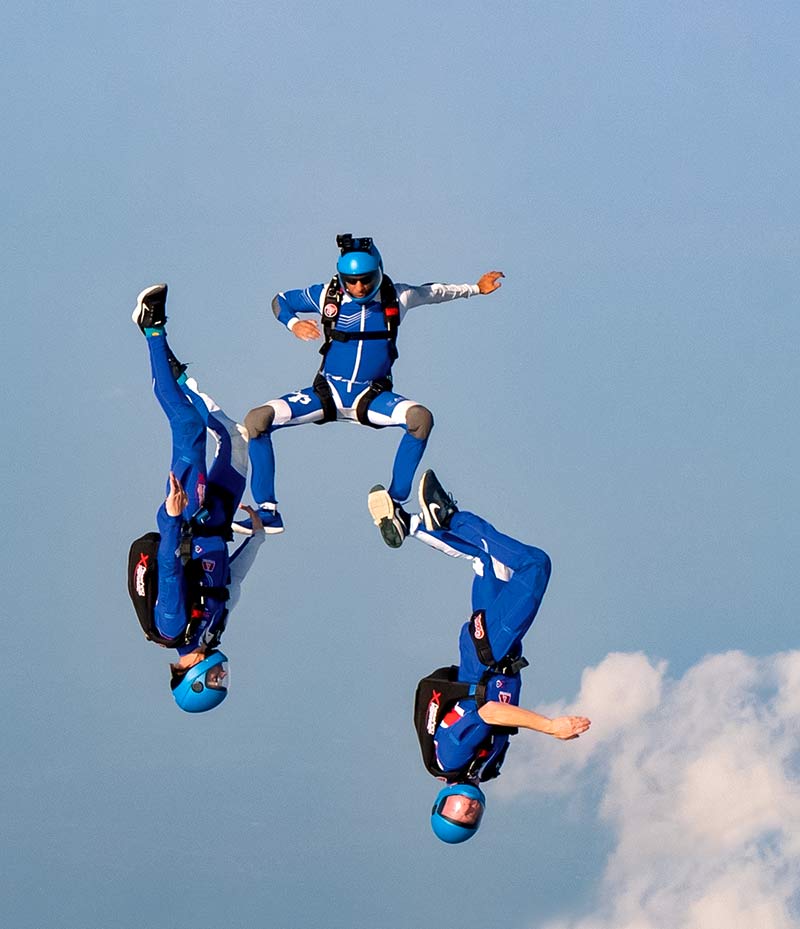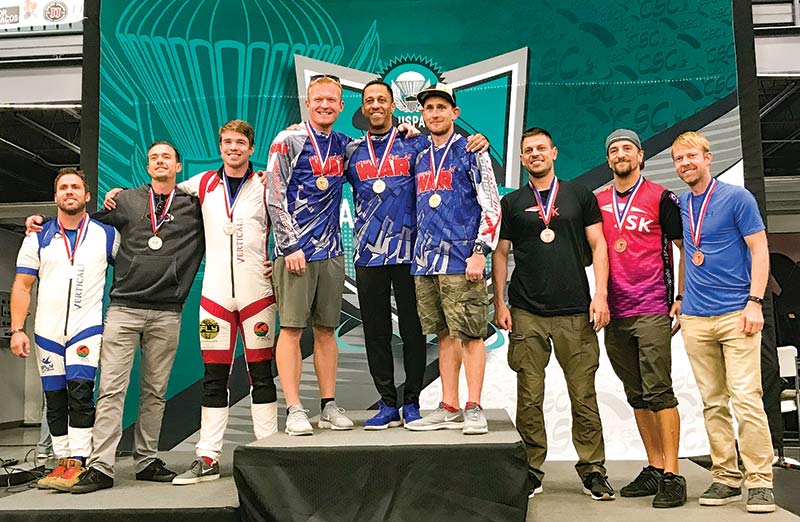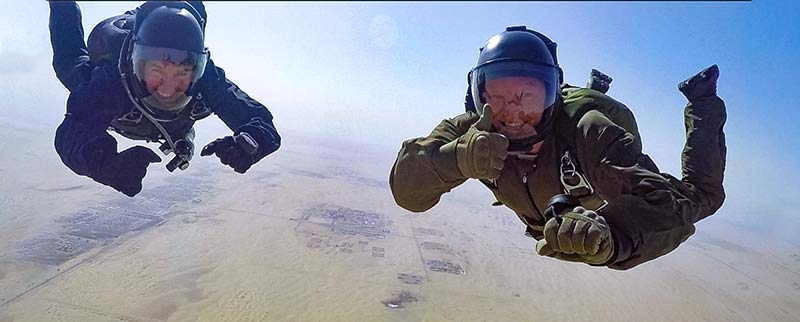Frontier Pilot Jumps at the Chance to Skydive
By John Perkinson, Senior Staff Writer

Training for the USPA National Parachuting and Skydiving Championships, Capt. Russell Lewis (Frontier), right, and his team practice for the event.
Capt. Russell “Rusty” Lewis (Frontier) has long been fascinated with the sky, but before he ever considered climbing into an airline cockpit, he was bailing out of airplanes. Lewis is a professional skydiver who has successfully performed nearly 10,000 jumps. He instructs and aids in the development of training components and has participated (and placed) in national competitions. Lewis has also worked with celebrities like Tom Cruise as a movie/television stuntman and consultant and participated in promotions for organizations like the National Football League.
The Frontier pilot’s range of jump-related experiences runs the gamut. From military-style high-altitude (HALO) skydiving to canopy (or docking) formations, from freefall competitions to water and night jumps, chances are good that he’s consulted about it, coached it, and, more impressively, performed it.
“It’s been 24 years since I first started jumping,” said Lewis, who was inspired by an older brother who signed up for a local skydiving course. Born and raised near Manchester, England, Lewis noted that both his father and brother were general aviation pilots and that, as a child, he spent many hours hanging out around airfields and airplanes.
Meeting people and traveling to some of the most scenic locations in the world are among the many reasons Lewis loves this exciting and adrenaline-charged sport. “You could be jumping over a mountain or a beach,” he remarked, adding that “it never gets old.” His most beautiful skydive, he noted, was above a narrow fjord in the middle of a snow-covered glacier in Iceland. It was during the winter, and he was performing a stunt for a television show.
Free Fallin’
Living in the UK, Lewis traveled to the United States as a consultant of SkyVenture, an indoor skydiving business and the predecessor of iFLY. In Orlando, Fla., he helped set up the first U.S. operation, which included a rudimentary wall-to-wall airflow wind tunnel 12 feet in diameter. iFLY now has more than 90 locations worldwide, featuring updated, state-of-the-art facilities.
“Spending a lot of time at the tunnel, I was able to get to know the staff well,” he recollected. “This eventually led to them agreeing to hire me and supported the necessary process required for me to legally work in the United States. I started as an instructor.”
Lewis eventually became manager at SkyVenture Orlando and, in 2006, moved out west where he assumed the position of lead instructor/manager for SkyVenture Colorado (now iFLY Denver). “Today I manage all training and safety-related aspects of our facilities around the world,” he noted.
The British native also went to work for Mile-Hi Skydiving Center, a business in Longmont, Colo., offering tandem and fun jumps, skydive license training, instructor rating courses, and other skills classes. He worked as both an instructor and a pilot, building his flight hours while flying customers in one of the outfit’s Beech King Air 90s or a de Havilland Canada DHC-6 Twin Otter.
Adding to his credibility in the skydiving community, Lewis is the director of safety and training for the International Bodyflight Association, which assists indoor skydiving businesses with the requisite platforms, training, and other materials required to operate wind tunnels. He’s also a certified United States Parachute Association (USPA) accelerated freefall instructor.
Not content with limiting himself to parachuting pursuits, Lewis flew for a private jet corporation before transitioning to Frontier Airlines in 2015 where he’s currently a Las Vegas, Nev.-based A320 captain. In his “spare” time, he serves as a member of his pilot group’s Hotel Committee.
Might as Well Jump

Lewis and his team place first in their event at the 2018 USPA National Parachuting and Skydiving Championships.
During the last five years, Lewis has participated in several events as part of the annual USPA National Parachuting and Skydiving Championships, which features seven competition disciplines.
Lewis worked as part of a three-person team along with another aerial performer and a videographer. At these contests, a meet coordinator specifies a sequence of maneuvers and the order in which they must be performed. “You then repeat that sequence as many times as you can. Each maneuver earns a point, and you conduct these routines in the process of 10 skydives,” he said.
Before Lewis moved to the United States, he participated in British competitions, performing as part of a four-person team. “However, as I start to get a bit older and wind down, I think I’ll let the kids take over. At this point I’m essentially retired from competitive skydiving. But I have a few other projects in mind,” he commented, adding, “I’ve been rather fortunate, thankfully.”
Some of that good fortune is the result of thorough preparation and, frankly, good luck. The FAA requires a second reserve parachute in all skydiving equipment, which must be certified and packed by a licensed FAA parachute rigger. Whether you’re making your first tandem jump or going for your 10,000th skydive, you’re required to have two parachutes. Lewis observed that in all of his jumps—since he began the sport at age 16—he’s never needed to deploy his reserve chute.

Lewis, right, and Tom Cruise above the desert in Abu Dhabi in the United Arab Emirates on a training jump to prepare for filming Mission: Impossible—Fallout.
Mission: Impossible
As part of his airborne activities, Lewis has consulted on and performed stunts for a variety of movies and television shows, most notably the 2018 action spy thriller Mission: Impossible—Fallout. He recalled, “I spent quite a lot of time working with Tom Cruise. He had previously done a few skydives in the 1980s but came to us asking for help. He said he needed to do a stunt for a movie, and we worked with him till he got to the point that he could perform the maneuver.
“Things get a bit unorthodox,” commented Lewis, observing that movie stunts can be preoccupying and place you in precarious positions. Mission: Impossible—Fallout featured a HALO jump at twilight. In the scene, Cruise pursues an agent out the back of a Boeing C-17 Globemaster, assisting the later unconscious skydiver by deploying his parachute at a very low altitude. Lewis added, “Interestingly, the guy he chased out the back of the aircraft and saved was me.”
The ALPA pilot’s stuntman performances include scenes in television shows like the NBC series Blindspot. Lewis was a stunt double for character Kurt Weller, played by Australian actor Sullivan Stapleton, appearing in an episode of the program’s 2019 season.
Lewis observed that he doesn’t get nervous before most jumps because he stresses safety in all his preparations and works with a very professional crew. Nonetheless, there are instances in which he’s been a bit anxious.
Several years ago, Lewis worked with a four-person team called the Thunderstorm, which skydives into Empower Field before Denver Broncos football games. On occasion, these performances are scheduled for nighttime games, adding to the complexity of the jump. The frenzied routine ends with maneuvering around a maze of crisscrossing wire (e.g., field goal, Sky Cam, and 50-yard-line cables) as the skydivers navigate their way onto the stadium turf at a brisk 60 miles per hour.
“The first time we jumped, the stadium was empty because it was a test run,” said Lewis. “I was more scared then than I was on my very first skydive, trying to squeeze into that very tight area. Then you put 76,000 people in the stadium the next day and do it again.”
Lewis acknowledged, “We could hear the roar of the crowd high above the field. It was the definition of exhilaration.”

